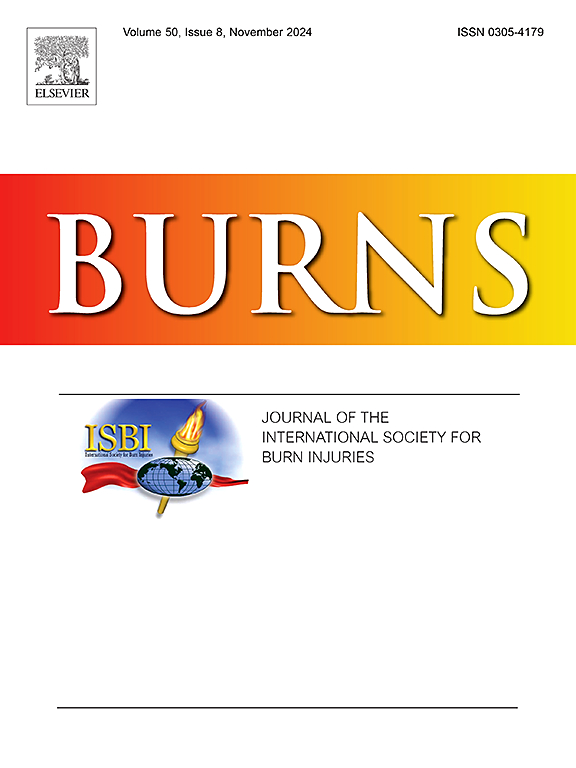Have the recent advancements in wound repair and scar management technology improved the quality of life in burn patients?
IF 3.2
3区 医学
Q2 CRITICAL CARE MEDICINE
引用次数: 0
Abstract
Background
The negative physical and psychosocial impact of scars, in particular burn scars, has been well documented. Altered personal appearance together with impaired function related to pain, heat intolerance, and contracture formation may last a lifetime and eventually can lead to low self-esteem and poor social and psychological adjustments. Though most patients recover within the first years and many report generally good life satisfaction and moderate quality of life (QoL), some severely burned patients continue to report impaired QoL almost 10 years after injury. It is repeatedly mentioned in the literature that patients’ QoL and health-related quality of life (HRQoL) can be improved by improving wound healing and burn scar quality. Determining whether advances in burn wound healing and scar management modalities are positively impacting the lives of surviving patients is the aim of this review.
Methods
A systematic literature review was used to identify studies measuring QoL of patients surviving severe burn injuries following various interventions to improve burn wound healing and scar quality.
Results
A limited number of studies was identified. Given the limited available data, a narrative review approach including qualitative studies and reviews in addition to identifying common themes, trends, and gaps in the existing literature was deemed more appropriate for a comprehensive analysis.
Conclusion
The assumption that progress made in recent decades to improve burn wound healing and scar quality would improve QoL remains largely hypothetical. Except for functional release of burn scar contractures, improved scar aesthetic quality does not necessarily translate into improved QoL of surviving patients. Well-designed comparative studies are largely lacking.
最近伤口修复和疤痕管理技术的进步是否改善了烧伤患者的生活质量?
背景:疤痕,特别是烧伤疤痕对身体和心理的负面影响已经得到了充分的证明。个人外貌的改变以及与疼痛、热耐受和挛缩形成相关的功能受损可能持续一生,并最终导致低自尊和不良的社会和心理适应能力。虽然大多数患者在最初几年内康复,许多人报告总体上有良好的生活满意度和中等的生活质量(QoL),但一些严重烧伤患者在受伤后近10年仍然报告生活质量受损。文献中多次提到,通过改善创面愈合和烧伤疤痕质量,可以提高患者的QoL和健康相关生活质量(HRQoL)。确定烧伤创面愈合和疤痕管理模式的进步是否对存活患者的生活产生积极影响是本综述的目的。方法:通过系统的文献回顾,对重度烧伤患者在采取各种干预措施改善烧伤创面愈合和疤痕质量后的生活质量进行研究。结果:确定了数量有限的研究。鉴于现有数据有限,除了确定现有文献中的共同主题、趋势和差距外,还包括定性研究和评论的叙述性综述方法被认为更适合进行全面分析。结论:近几十年来在改善烧伤创面愈合和疤痕质量方面取得的进展将改善生活质量的假设在很大程度上仍然是假设的。除了烧伤瘢痕挛缩的功能释放外,瘢痕美学质量的改善并不一定转化为生存患者生活质量的改善。精心设计的比较研究在很大程度上缺乏。
本文章由计算机程序翻译,如有差异,请以英文原文为准。
求助全文
约1分钟内获得全文
求助全文
来源期刊

Burns
医学-皮肤病学
CiteScore
4.50
自引率
18.50%
发文量
304
审稿时长
72 days
期刊介绍:
Burns aims to foster the exchange of information among all engaged in preventing and treating the effects of burns. The journal focuses on clinical, scientific and social aspects of these injuries and covers the prevention of the injury, the epidemiology of such injuries and all aspects of treatment including development of new techniques and technologies and verification of existing ones. Regular features include clinical and scientific papers, state of the art reviews and descriptions of burn-care in practice.
Topics covered by Burns include: the effects of smoke on man and animals, their tissues and cells; the responses to and treatment of patients and animals with chemical injuries to the skin; the biological and clinical effects of cold injuries; surgical techniques which are, or may be relevant to the treatment of burned patients during the acute or reconstructive phase following injury; well controlled laboratory studies of the effectiveness of anti-microbial agents on infection and new materials on scarring and healing; inflammatory responses to injury, effectiveness of related agents and other compounds used to modify the physiological and cellular responses to the injury; experimental studies of burns and the outcome of burn wound healing; regenerative medicine concerning the skin.
 求助内容:
求助内容: 应助结果提醒方式:
应助结果提醒方式:


